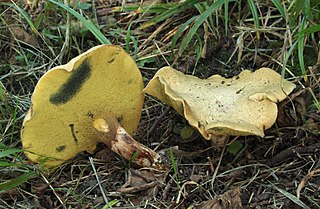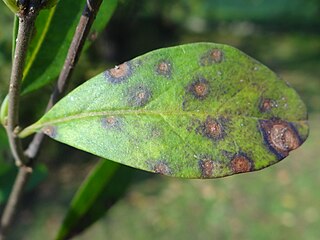
Pier Andrea Saccardo was an Italian botanist and mycologist. He was also the author of a color classification system that he called Chromotaxia. He was elected to the Linnean Society in 1916 as a foreign member. His multi-volume Sylloge Fungorum was one of the first attempts to produce a comprehensive treatise on the fungi which made use of the spore-bearing structures for classification.
Ramularia coryli is a fungal plant pathogen infecting hazelnuts.
Ramularia necator is a fungal plant pathogen infecting coconut palms.
Monochaetia coryli is a species of fungus in the family Amphisphaeriaceae. It is a plant pathogen.
Graphium rigidum is a species of fungus in the family Microascaceae. It is a plant pathogen. The fungus was originally described as new to science in 1794 by Christiaan Hendrik Persoon, as Stilbum rigidum. Pier Andrea Saccardo transferred it to the genus Graphium in 1886.

Gyrodon lividus, commonly known as the alder bolete, is a pored mushroom bearing close affinity to the genus Paxillus. Although found predominantly in Europe, where it grows in a mycorrhizal association with alder, it has also recorded from China, Japan and California. Fruit bodies are distinguished from other boletes by decurrent bright yellow pores that turn blue-grey on bruising. G. lividus mushrooms are edible.

Venturia is a genus of fungi in the family Venturiaceae. First identified in 1882, species in the genus are plant pathogens. Venturia is widespread and the genus contains an estimated 58 species, or 130 species. Anamorphs were historically represented in the genus Fusicladium.

Favolus, or honeycomb fungus, is a genus of fungi in the family Polyporaceae. The fruit bodies of Favolus species are fleshy with radially arranged pores on the underside of the cap that are angular and deeply pitted, somewhat resembling a honeycomb.

Caripia is a fungal genus in the family Marasmiaceae. The genus is monotypic, containing the single species Caripia montagnei, commonly known as the pod parachute. It is found in tropical and subtropical regions of the Americas. Formerly classified in the Stereales, molecular analysis published in 2002 demonstrated that the fungus is a reduced form of the closely related Gymnopus.

Clavulinopsis umbrinella, commonly known as the beige coral, is a coral mushroom in the family Clavariaceae. Fruit bodies are initially white before turning pale brown with darker brown tips. Originally described in 1860, it is known to occur in Europe and North America where it grows in grass. It is not a common species.
Pluteus aethalus is a species of agaric fungus in the family Pluteaceae. It is found in Cuba. The species was originally named Agaricus aethalus by Miles Joseph Berkeley & Moses Ashley Curtis in 1869, and later transferred to the genus Pluteus by Pier Andrea Saccardo in 1887. It is classified in Pluteus section Celluloderma, subsection Mixtini.

Mycena subcaerulea is a species of mushroom-forming fungus in the family Mycenaceae. It produces small, thin-fleshed fruitbodies with pale bluish-green caps upon slender stipes. The centers of the caps are darker in colour than the margins, and the cap cuticle can be peeled off. The fungus was first described in 1873 as Agaricus subcaeruleus by American mycologist Charles Horton Peck. His original collections, found growing on the trunks of decaying beech trees, were made in woods of the Adirondack Mountains in Upstate New York. Pier Andrea Saccardo transferred the species to the genus Mycena in 1887.
Clavaria versatilis is a species of coral fungus in the family Clavariaceae. It was first described scientifically by French mycologist Lucien Quélet in 1893 as a species of Ramaria. Pier Andrea Saccardo and Alessandro Trotter transferred it to the genus Clavaria in 1912.

Geopyxis vulcanalis, commonly known as the vulcan pixie cup, is a species of cup fungus in the family Pyronemataceae. It was first described scientifically in 1878 by American mycologist Charles Horton Peck, from collections made in the Adirondack Mountains in Upstate New York. Pier Andrea Saccardo transferred it to the genus Geopyxis in 1889.
Cerocorticium molle is a species of crust fungus in the family Meruliaceae.
Harzia is a genus of seed-borne fungus that occurs in the soil. It has been categorized in the Ceratostomataceae family. The genus Harzia originally contained three accepted species: Harzia acremonioides, Harzia verrucose, and Harzia velatea. Within the genus Harzia, Harzia acremonioides is one of the most common species that can be found in all climate regions around the world.
Brachysporium is a genus of anamorphic fungi in the family Trichosphaeriaceae. It has 25 species. The genus was circumscribed in 1886 by Pier Andrea Saccardo, with Brachysporium obovatum assigned as the type species. The genus Cryptadelphia, circumscribed in 2004 to contain six presumed teleomorphs of Brachysporium, has since been placed in synonymy with Brachysporium.

Leucocoprinus ianthinus is a species of mushroom producing fungus in the family Agaricaceae. Like several other Leucocoprinus species it may have originated in a tropical climate but now finds a home in plant pots, greenhouses and compost piles in many countries. It is not seen in plant pots with the same kind of regularity as the well known Leucocoprinus birnbaumii and not seen in the wild as frequently as Leucocoprinus brebissonii.

Thedgonia is a genus of fungi in the family Drepanopezizaceae of the order Helotiales. They have been recorded in most places in Europe including Great Britain.
Leucocoprinus bulbipes is a species of mushroom producing fungus in the family Agaricaceae.









